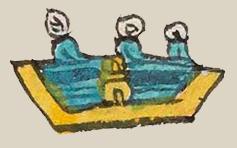Coyolapan (Mdz13v)
This compound glyph for the place name Coyolapan has two principal features. One is the bell (coyolli), and the other is the cross-section of a canal (apantli), where the bell has been superimposed. This -apan provides the locative suffix that means on the water. The bell is vertical and has a yellow color. The canal or waterway is trapezoidal in shape, with turquoise blue water and black horizontal lines of movement or current, and one of these lines is especially thick toward the middle. Splashing off the top of the water are a white turbinate shell and white droplets/beads that are classic iconography for water. The waterway is reinforced on the bottom and sides with a thick yellow outline.
Stephanie Wood
Frances Karttunen suggests a reading of "On Bell Lake." There is a contemporary Coyolapan in the state of Oaxaca, which, by association with other pueblos in the Codex, is probably the one. Berdan and Anawalt cite Michael Smith (1973, 50) as saying that this Coyolapan is a Mixtec town, and its original name was Saba Yucu. There is also a Coyolapa today in the state of Puebla. Perhaps the lakes associated with these place names had the shape of a bell.
Stephanie Wood
coyolapan. puo
Coyolapan, pueblo
Stephanie Wood
c. 1541, but by 1553 at the latest
Stephanie Wood
bells, waterways, canals, canales, cascabeles, campanillas, campanas, pinjantes, nombres de lugares

coyol(li), bell(s), https://nahuatl.wired-humanities.org/content/coyolli
apan(tli), canal(s) or waterway(s), https://nahuatl.wired-humanities.org/content/apantli
-apan (locative suffix), on or at the waters of, https://nahuatl.wired-humanities.org/content/apan-0
a(tl), water, https://nahuatl.wired-humanities.org/content/atl
"On Bell Lake" [Frances Karttunen, unpublished manuscript, used here with her permission.]
"On the Water of the Bell" (Berdan and Anawalt, 1992, vol. 1, p. 181)
"En el Lago de la Campanilla"
Stephanie Wood
Codex Mendoza, folio 13 verso, https://digital.bodleian.ox.ac.uk/objects/2fea788e-2aa2-4f08-b6d9-648c00..., image 37 of 188.
The Bodleian Libraries, University of Oxford, hold the original manuscript, the MS. Arch. Selden. A. 1. This image is published here under the UK Creative Commons, “Attribution-NonCommercial-ShareAlike 3.0 License” (CC-BY-NC-SA 3.0).







